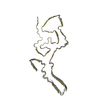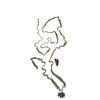+ Open data
Open data
- Basic information
Basic information
| Entry |  | |||||||||
|---|---|---|---|---|---|---|---|---|---|---|
| Title | Chronic wasting disease prion fibril | |||||||||
 Map data Map data | CWD density modified real-space symmetrized map | |||||||||
 Sample Sample |
| |||||||||
 Keywords Keywords | Prion / Chronic Wasting Disease / Deer / Fibril / GPI-anchor / PrP / Infectious / Amyloid / Brain-derived / ex vivo / Prion strain / PROTEIN FIBRIL | |||||||||
| Function / homology |  Function and homology information Function and homology informationside of membrane / protein homooligomerization / Golgi apparatus / metal ion binding / plasma membrane Similarity search - Function | |||||||||
| Biological species |  Odocoileus virginianus (white-tailed deer) Odocoileus virginianus (white-tailed deer) | |||||||||
| Method | helical reconstruction / cryo EM / Resolution: 2.8 Å | |||||||||
 Authors Authors | Caughey B / Hoyt F / Alam P / Artikis E / Soukup J / Hughson A / Schwartz C / Race B / Barbian K | |||||||||
| Funding support |  United States, 1 items United States, 1 items
| |||||||||
 Citation Citation |  Journal: Acta Neuropathol / Year: 2024 Journal: Acta Neuropathol / Year: 2024Title: Cryo-EM structure of a natural prion: chronic wasting disease fibrils from deer. Authors: Parvez Alam / Forrest Hoyt / Efrosini Artikis / Jakub Soukup / Andrew G Hughson / Cindi L Schwartz / Kent Barbian / Michael W Miller / Brent Race / Byron Caughey /  Abstract: Chronic wasting disease (CWD) is a widely distributed prion disease of cervids with implications for wildlife conservation and also for human and livestock health. The structures of infectious prions ...Chronic wasting disease (CWD) is a widely distributed prion disease of cervids with implications for wildlife conservation and also for human and livestock health. The structures of infectious prions that cause CWD and other natural prion diseases of mammalian hosts have been poorly understood. Here we report a 2.8 Å resolution cryogenic electron microscopy-based structure of CWD prion fibrils from the brain of a naturally infected white-tailed deer expressing the most common wild-type PrP sequence. Like recently solved rodent-adapted scrapie prion fibrils, our atomic model of CWD fibrils contains single stacks of PrP molecules forming parallel in-register intermolecular β-sheets and intervening loops comprising major N- and C-terminal lobes within the fibril cross-section. However, CWD fibrils from a natural cervid host differ markedly from the rodent structures in many other features, including a ~ 180° twist in the relative orientation of the lobes. This CWD structure suggests mechanisms underlying the apparent CWD transmission barrier to humans and should facilitate more rational approaches to the development of CWD vaccines and therapeutics. | |||||||||
| History |
|
- Structure visualization
Structure visualization
| Supplemental images |
|---|
- Downloads & links
Downloads & links
-EMDB archive
| Map data |  emd_47020.map.gz emd_47020.map.gz | 42.4 MB |  EMDB map data format EMDB map data format | |
|---|---|---|---|---|
| Header (meta data) |  emd-47020-v30.xml emd-47020-v30.xml emd-47020.xml emd-47020.xml | 16.1 KB 16.1 KB | Display Display |  EMDB header EMDB header |
| FSC (resolution estimation) |  emd_47020_fsc.xml emd_47020_fsc.xml | 13.6 KB | Display |  FSC data file FSC data file |
| Images |  emd_47020.png emd_47020.png | 75.9 KB | ||
| Masks |  emd_47020_msk_1.map emd_47020_msk_1.map | 216 MB |  Mask map Mask map | |
| Filedesc metadata |  emd-47020.cif.gz emd-47020.cif.gz | 5.7 KB | ||
| Others |  emd_47020_half_map_1.map.gz emd_47020_half_map_1.map.gz emd_47020_half_map_2.map.gz emd_47020_half_map_2.map.gz | 171.8 MB 171.8 MB | ||
| Archive directory |  http://ftp.pdbj.org/pub/emdb/structures/EMD-47020 http://ftp.pdbj.org/pub/emdb/structures/EMD-47020 ftp://ftp.pdbj.org/pub/emdb/structures/EMD-47020 ftp://ftp.pdbj.org/pub/emdb/structures/EMD-47020 | HTTPS FTP |
-Validation report
| Summary document |  emd_47020_validation.pdf.gz emd_47020_validation.pdf.gz | 1013 KB | Display |  EMDB validaton report EMDB validaton report |
|---|---|---|---|---|
| Full document |  emd_47020_full_validation.pdf.gz emd_47020_full_validation.pdf.gz | 1012.5 KB | Display | |
| Data in XML |  emd_47020_validation.xml.gz emd_47020_validation.xml.gz | 21.9 KB | Display | |
| Data in CIF |  emd_47020_validation.cif.gz emd_47020_validation.cif.gz | 28.6 KB | Display | |
| Arichive directory |  https://ftp.pdbj.org/pub/emdb/validation_reports/EMD-47020 https://ftp.pdbj.org/pub/emdb/validation_reports/EMD-47020 ftp://ftp.pdbj.org/pub/emdb/validation_reports/EMD-47020 ftp://ftp.pdbj.org/pub/emdb/validation_reports/EMD-47020 | HTTPS FTP |
-Related structure data
| Related structure data |  9dmyMC  9dmzC C: citing same article ( M: atomic model generated by this map |
|---|---|
| Similar structure data | Similarity search - Function & homology  F&H Search F&H Search |
- Links
Links
| EMDB pages |  EMDB (EBI/PDBe) / EMDB (EBI/PDBe) /  EMDataResource EMDataResource |
|---|---|
| Related items in Molecule of the Month |
- Map
Map
| File |  Download / File: emd_47020.map.gz / Format: CCP4 / Size: 216 MB / Type: IMAGE STORED AS FLOATING POINT NUMBER (4 BYTES) Download / File: emd_47020.map.gz / Format: CCP4 / Size: 216 MB / Type: IMAGE STORED AS FLOATING POINT NUMBER (4 BYTES) | ||||||||||||||||||||||||||||||||||||
|---|---|---|---|---|---|---|---|---|---|---|---|---|---|---|---|---|---|---|---|---|---|---|---|---|---|---|---|---|---|---|---|---|---|---|---|---|---|
| Annotation | CWD density modified real-space symmetrized map | ||||||||||||||||||||||||||||||||||||
| Projections & slices | Image control
Images are generated by Spider. | ||||||||||||||||||||||||||||||||||||
| Voxel size | X=Y=Z: 0.8284 Å | ||||||||||||||||||||||||||||||||||||
| Density |
| ||||||||||||||||||||||||||||||||||||
| Symmetry | Space group: 1 | ||||||||||||||||||||||||||||||||||||
| Details | EMDB XML:
|
-Supplemental data
-Mask #1
| File |  emd_47020_msk_1.map emd_47020_msk_1.map | ||||||||||||
|---|---|---|---|---|---|---|---|---|---|---|---|---|---|
| Projections & Slices |
| ||||||||||||
| Density Histograms |
-Half map: #1
| File | emd_47020_half_map_1.map | ||||||||||||
|---|---|---|---|---|---|---|---|---|---|---|---|---|---|
| Projections & Slices |
| ||||||||||||
| Density Histograms |
-Half map: #2
| File | emd_47020_half_map_2.map | ||||||||||||
|---|---|---|---|---|---|---|---|---|---|---|---|---|---|
| Projections & Slices |
| ||||||||||||
| Density Histograms |
- Sample components
Sample components
-Entire : Naturally occurring chronic wasting disease prion fibril
| Entire | Name: Naturally occurring chronic wasting disease prion fibril |
|---|---|
| Components |
|
-Supramolecule #1: Naturally occurring chronic wasting disease prion fibril
| Supramolecule | Name: Naturally occurring chronic wasting disease prion fibril type: complex / ID: 1 / Parent: 0 / Macromolecule list: all |
|---|---|
| Source (natural) | Organism:  Odocoileus virginianus (white-tailed deer) / Organ: Brain Odocoileus virginianus (white-tailed deer) / Organ: Brain |
-Macromolecule #1: Major prion protein
| Macromolecule | Name: Major prion protein / type: protein_or_peptide / ID: 1 / Number of copies: 5 / Enantiomer: LEVO |
|---|---|
| Source (natural) | Organism:  Odocoileus virginianus (white-tailed deer) Odocoileus virginianus (white-tailed deer) |
| Molecular weight | Theoretical: 27.965486 KDa |
| Sequence | String: MVKSHIGSWI LVLFVAMWSD VGLCKKRPKP GGGWNTGGSR YPGQGSPGGN RYPPQGGGGW GQPHGGGWGQ PHGGGWGQPH GGGWGQPHG GGGWGQGGTH SQWNKPSKPK TNMKHVAGAA AAGAVVGGLG GYMLGSAMSR PLIHFGNDYE DRYYRENMYR Y PNQVYYRP ...String: MVKSHIGSWI LVLFVAMWSD VGLCKKRPKP GGGWNTGGSR YPGQGSPGGN RYPPQGGGGW GQPHGGGWGQ PHGGGWGQPH GGGWGQPHG GGGWGQGGTH SQWNKPSKPK TNMKHVAGAA AAGAVVGGLG GYMLGSAMSR PLIHFGNDYE DRYYRENMYR Y PNQVYYRP VDQYNNQNTF VHDCVNITVK QHTVTTTTKG ENFTETDIKM MERVVEQMCI TQYQRESQAY YQRGASVILF SS PPVILLI SFLIFLIVG UniProtKB: Major prion protein |
-Experimental details
-Structure determination
| Method | cryo EM |
|---|---|
 Processing Processing | helical reconstruction |
| Aggregation state | filament |
- Sample preparation
Sample preparation
| Buffer | pH: 7.4 |
|---|---|
| Grid | Model: Quantifoil R1.2/1.3 / Material: COPPER / Mesh: 300 |
| Vitrification | Cryogen name: ETHANE / Chamber humidity: 90 % / Chamber temperature: 295 K / Instrument: LEICA EM GP |
- Electron microscopy
Electron microscopy
| Microscope | FEI TITAN KRIOS |
|---|---|
| Specialist optics | Energy filter - Name: GIF Bioquantum / Energy filter - Slit width: 20 eV |
| Image recording | Film or detector model: GATAN K3 BIOCONTINUUM (6k x 4k) / Average electron dose: 60.0 e/Å2 |
| Electron beam | Acceleration voltage: 300 kV / Electron source:  FIELD EMISSION GUN FIELD EMISSION GUN |
| Electron optics | Illumination mode: FLOOD BEAM / Imaging mode: BRIGHT FIELD / Cs: 2.7 mm / Nominal defocus max: 3.0 µm / Nominal defocus min: 0.5 µm / Nominal magnification: 105000 |
| Sample stage | Specimen holder model: FEI TITAN KRIOS AUTOGRID HOLDER / Cooling holder cryogen: NITROGEN |
| Experimental equipment |  Model: Titan Krios / Image courtesy: FEI Company |
+ Image processing
Image processing
-Atomic model buiding 1
| Refinement | Space: REAL / Protocol: AB INITIO MODEL |
|---|---|
| Output model |  PDB-9dmy: |
 Movie
Movie Controller
Controller







 Z (Sec.)
Z (Sec.) Y (Row.)
Y (Row.) X (Col.)
X (Col.)













































